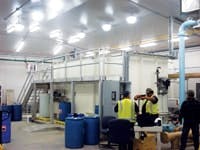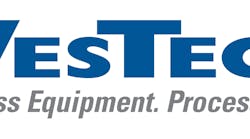The Northern Village of Île-à-la-Crosse, Saskatchewan, Canada, operates a surface water treatment plant for its drinking water supply. The water source is Lac Île-à-la-Crosse in northern Saskatchewan, with its corresponding cold water temperatures.
The inlet turbidity typically is less than 5 NTU, but the raw water total organic carbon (TOC) can be as high as 12 mg/L. Previously, the system included two conventional packaged treatment units consisting of flocculation, tube settling and granular media filtration. The filter run lengths were short, producing excessive wastewater and low system production efficiency. The high TOC was not properly addressed, which resulted in trihalomethane (THM) concentrations that were out of compliance with regulatory standards. In addition, during high demand periods in the summer, the water was sometimes out of compliance for turbidity, resulting in advisories to boil the water. The existing package treatment systems were also near the end of their useful life. The city contracted to design a new water treatment system that would produce higher quality water, increase capacity and improve overall system efficiency.
A Multi-Barrier Solution
Initially, a consultant investigated the feasibility of replacing the existing units with larger-package flocculation, settling and filtration systems. They ultimately selected a new treatment process: the Trident HS package treatment system from WesTech Eng. Its design consists of two-stage clarification and mixed media filtration in a single tank configuration.
“They needed a system that would handle the high TOC and be able to operate consistently with the low raw water temperature,” said Rich Ross, regional product manager at WesTech Eng. “The Trident HS technology met those needs.”
The system process consists of solids contacting with external sludge recirculation prior to tube settling for removing settling solids, followed by upflow adsorption clarification through a bed of buoyant media, and mixed media filtration for final polishing. All three treatment stages are combined in a single packaged treatment system. This multi-barrier approach allows the system to dampen variable contaminant loads while increasing system net production with a smaller footprint.
The water first is chemically treated with a polyaluminum chloride coagulant and non-ionic polymer. A static mixer is used to ensure that the chemicals, raw water and previously settled solids are thoroughly mixed. The water then enters the bottom of the tube settler compartment, where the bulk of the solids settle. The sludge concentration below the tube settlers is typically 3,000 to 5,000 mg/L, which acts as an effective buffer to variable influent solids loads. Because the influent solids concentration typically is much lower than this sludge inventory concentration, variations in influent solids are dampened by the higher concentrated inventory. This gives a more consistent solids load to the tube settling section, allowing for consistent treatment.
Settled sludge is collected from the tank bottom using a moving sludge collection header. The sludge is recirculated by a pump to the static mixer, where it is mixed with the raw water. Returning sludge allows the system to operate in a solids contact mode, which has been shown to effectively remove TOC. This makes optimal use of process chemistry, increases sludge concentration, moderates solids loading and improves settling. Periodically, sludge is blown down to maintain the appropriate sludge concentration and to prevent concentration of pathogens.
Effluent from the tube settlers is collected in a header/lateral system and a non-ionic filter aid polymer is added. The water is pumped upward through the adsorption clarifier section. This second barrier in the clarification system ensures that non-settling solids are removed prior to the filter, increasing filter run length and overall production efficiency. Buoyant media removes flocculated particles that did not settle in the tube settler. The use of buoyant media allows for the water to flow up through the adsorption clarification system without expanding the media bed. The media is rolled and scarified, which places a rough edge on the media to enhance solids capture capacity. Solids periodically are removed by adding air to the bottom of the clarifier. This lowers the bulk density of the water and air, expanding the media bed and flushing the solids out of the section. The turbulence of the air, combined with the flushing action of the water, ensures that the media bed is thoroughly cleaned.
The water overflows a weir into the mixed media filtration section. Mixed media consists of anthracite, sand and garnet to produce a constantly tightening filter bed. The filter media is directly retained on a laser-cut stainless steel media retainer to eliminate support gravel layers. A block style underdrain ensures even collection of the treated water as well as distribution of the backwash air and water, while maintaining a low profile. The filter is backwashed using simultaneous air and water to thoroughly clean the media. Backwash waste is collected with a low profile washtrough specifically designed to prevent media washout with an advanced baffling and solids separation design. After the mixed media filter, the treated water is sent to the clearwell for chlorination and distribution.
Chemical doses are flow controlled automatically by a programmable logic controller working in conjunction with an inlet flowmeter. An influent flowmeter allows flow pacing of the chemical feed systems. In addition, influent and intermediate turbidimeters continuously monitor the raw water quality and system performance. This automatic chemical dosing control system reduces operation time and optimizes chemical use, thus reducing overall system operating costs. Plant operators are able to adjust set points on the control system’s operator interface terminal to ensure proper operation.
Successful Treatment
Placed online within weeks, the new treatment system was designed for a flow rate of 56.8 cu meters per hour (250 gal per minute) using a single tank package treatment system. The raw water turbidity has been between 1 and 4 NTU. The raw water TOC has ranged between 7 and 12 mg/L. The system consistently produces treated water with a turbidity of 0.15 NTU or less. The THM concentration in the treated water measures about 78 µg/L.
Prior to the plant being placed online, the province began to consider lowering the compliance levels for THMs from 100 µg/L to 80 µg/L. The system is already operating in compliance with the new level. In addition, the filter run length is three times longer than it was with the previous system.
To date, the new Trident HS units have provided exceptional treatment results under difficult water quality conditions. Multi-barrier treatment will allow the plant to address current and future regulations for years to come.
Download: Here



